2005 RENAULT MEGANE Child safety
[x] Cancel search: Child safetyPage 11 of 250
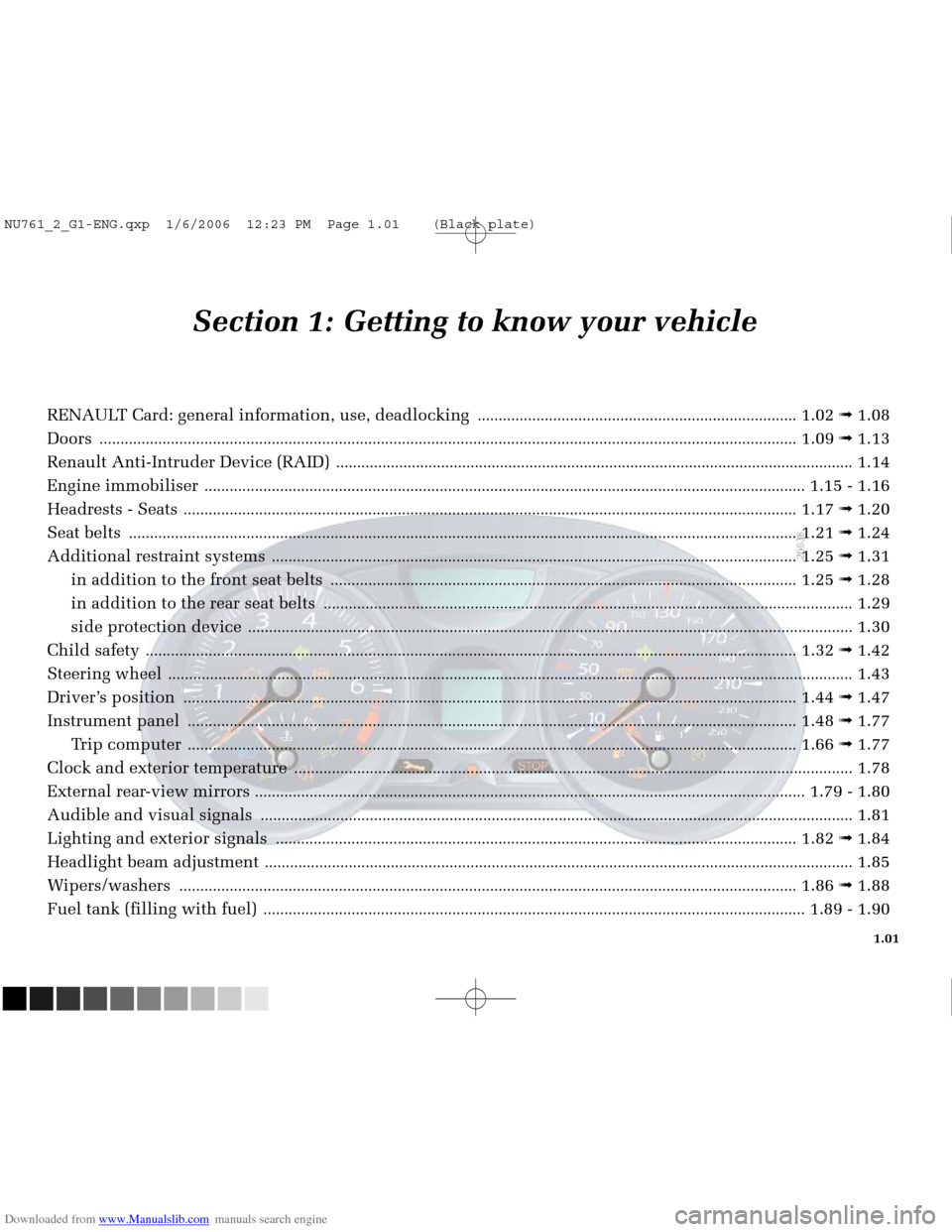
Downloaded from www.Manualslib.com manuals search engine
NU761_2_G1-FRA.qxd 10/11/05 15:52 Page 1.01
1.01
Section 1: Getting to know your vehicle
RENAULT Card: general information, use, deadlocking ........................................................................\
....1.02 ➟1.08
Doors
........................................................................\
....................................................... .......................................1.09 ➟1.13
Renault Anti-Intruder Device (RAID)
........................................................................\
...................................................1.14
Engine immobiliser
........................................................................\
....................................................... ................1.15 - 1.16
Headrests - Seats
........................................................................\
....................................................... ...................1.17 ➟1.20
Seat belts
........................................................................\
....................................................... ................................1.21 ➟1.24
Additional restraint systems
........................................................................\
.....................................................1.25 ➟1.31
in addition to the front seat belts
........................................................................\
.......................................1.25 ➟1.28
in addition to the rear seat belts
........................................................................\
......................................................1.29
side protection device
........................................................................\
....................................................... .................1.30
Child safety
........................................................................\
....................................................... ............................1.32 ➟1.42
Steering wheel
........................................................................\
....................................................... ....................................1.43
Driver’s position
........................................................................\
....................................................... ...................1.44 ➟1.47
Instrument panel
........................................................................\
....................................................... ..................1.48 ➟1.77
Trip computer
........................................................................\
....................................................... ..................1.66 ➟1.77
Clock and exterior temperature
........................................................................\
....................................................... ......1.78
External rear-view mirrors
........................................................................\
....................................................... ....1.79 - 1.80
Audible and visual signals
........................................................................\
....................................................... ..............1.81
Lighting and exterior signals
........................................................................\
....................................................1.82 ➟1.84
Headlight beam adjustment
........................................................................\
....................................................... .............1.85
Wipers/washers
........................................................................\
....................................................... ....................1.86 ➟1.88
Fuel tank (filling with fuel)
........................................................................\
....................................................... ..1.89 - 1.90
NU761_2_G1-ENG.qxp 1/6/2006 12:23 PM Page 1.01 (Black plate)
Page 20 of 250
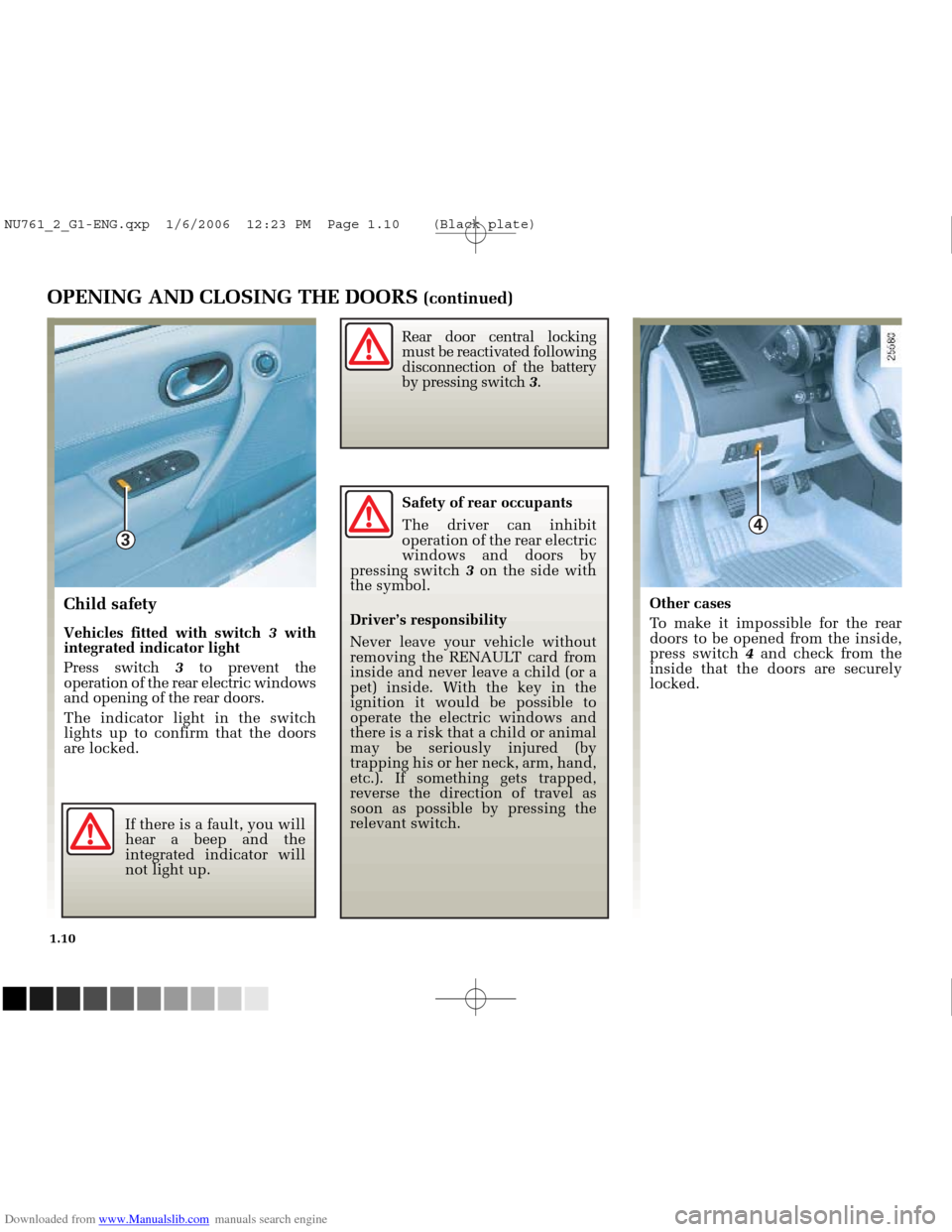
Downloaded from www.Manualslib.com manuals search engine
3
4
NU761_2_G1-FRA.qxd 10/11/05 15:53 Page 1.10
1.10
If there is a fault, you will
hear a beep and the
integrated indicator will
not light up.Rear door central locking
must be reactivated following
disconnection of the battery
by pressing switch
3.
Safety of rear occupants
The driver can inhibit
operation of the rear electric
windows and doors by
pressing switch 3on the side with
the symbol.
Driver’s responsibility
Never leave your vehicle without
removing the RENAULT card from
inside and never leave a child (or a
pet) inside. With the key in the
ignition it would be possible to
operate the electric windows and
there is a risk that a child or animal
may be seriously injured (by
trapping his or her neck, arm, hand,
etc.). If something gets trapped,
reverse the direction of travel as
soon as possible by pressing the
relevant switch.
OPENING AND CLOSING THE DOORS (continued)
Child safety
Vehicles fitted with switch 3with
integrated indicator light
Press switch 3to prevent the
operation of the rear electric windows
and opening of the rear doors.
The indicator light in the switch
lights up to confirm that the doors
are locked. Other cases
To make it impossible for the rear
doors to be opened from the inside,
press switch
4 and check from the
inside that the doors are securely
locked.
NU761_2_G1-ENG.qxp 1/6/2006 12:23 PM Page 1.10 (Black plate)
Page 42 of 250
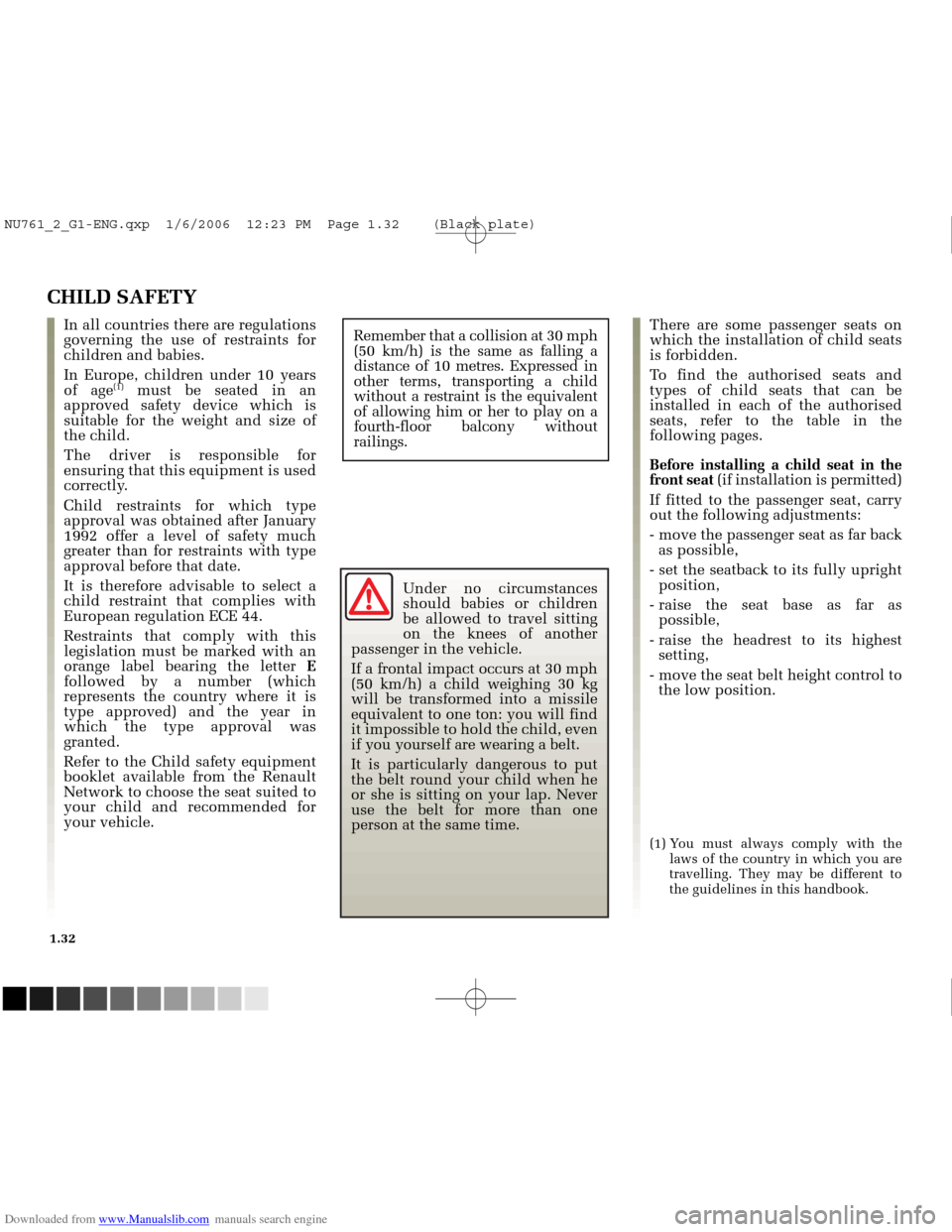
Downloaded from www.Manualslib.com manuals search engine
NU761_2_G1-FRA.qxd 10/11/05 15:53 Page 1.32
1.32
Under no circumstances
should babies or children
be allowed to travel sitting
on the knees of another
passenger in the vehicle.
If a frontal impact occurs at 30 mph
(50 km/h) a child weighing 30 kg
will be transformed into a missile
equivalent to one ton: you will find
it impossible to hold the child, even
if you yourself are wearing a belt.
It is particularly dangerous to put
the belt round your child when he
or she is sitting on your lap. Never
use the belt for more than one
person at the same time.
CHILD SAFETY
Remember that a collision at 30 mph
(50 km/h) is the same as falling a
distance of 10 metres. Expressed in
other terms, transporting a child
without a restraint is the equivalent
of allowing him or her to play on a
fourth-floor balcony without
railings.In all countries there are regulations
governing the use of restraints for
children and babies.
In Europe, children under 10 years
of age
(1)must be seated in an
approved safety device which is
suitable for the weight and size of
the child.
The driver is responsible for
ensuring that this equipment is used
correctly.
Child restraints for which type
approval was obtained after January
1992 offer a level of safety much
greater than for restraints with type
approval before that date.
It is therefore advisable to select a
child restraint that complies with
European regulation ECE 44.
Restraints that comply with this
legislation must be marked with an
orange label bearing the letter E
followed by a number (which
represents the country where it is
type approved) and the year in
which the type approval was
granted.
Refer to the Child safety equipment
booklet available from the Renault
Network to choose the seat suited to
your child and recommended for
your vehicle. There are some passenger seats on
which the installation of child seats
is forbidden.
To find the authorised seats and
types of child seats that can be
installed in each of the authorised
seats, refer to the table in the
following pages.
Before installing a child seat in the
front seat
(if installation is permitted)
If fitted to the passenger seat, carry
out the following adjustments:
- move the passenger seat as far back as possible,
- set the seatback to its fully upright position,
- raise the seat base as far as possible,
- raise the headrest to its highest setting,
- move the seat belt height control to the low position.
(1) You must always comply with the
laws of the country in which you are
travelling. They may be different to
the guidelines in this handbook.
NU761_2_G1-ENG.qxp 1/6/2006 12:23 PM Page 1.32 (Black plate)
Page 43 of 250
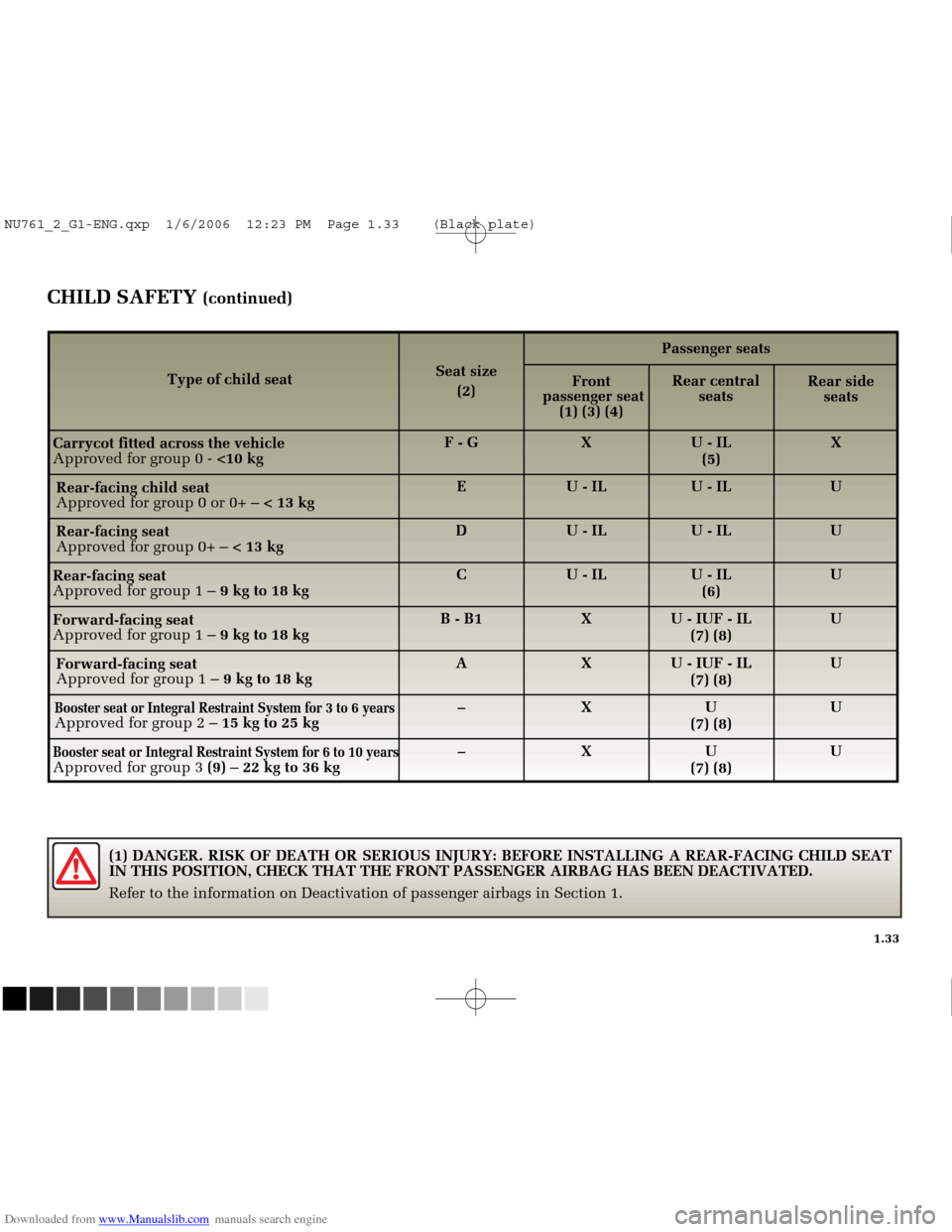
Downloaded from www.Manualslib.com manuals search engine
NU761_2_G1-FRA.qxd 10/11/05 15:53 Page 1.33
1.33
CHILD SAFETY (continued)
Type of child seat
Carrycot fitted across the vehicle
Approved for group 0 - <10 kg
Rear-facing seat
Approved for group 0+ – < 13 kg
Rear-facing child seat
Approved for group 0 or 0+ –
< 13 kg
Rear-facing seat
Approved for group 1 – 9 kg to 18 kg
Forward-facing seat
Approved for group 1 – 9 kg to 18 kg
Forward-facing seat
Approved for group 1 –
9 kg to 18 kg
Booster seat or Integral Restraint System for 6 to 10 yearsApproved for group 3 (9) – 22 kg to 36 kg Seat size
(2) Passenger seats
E
F - G
–
A
B - B1
C
D
X X X
U - IL
U - IL U - IL X
Front
passenger seat (1) (3) (4)
U
(7) (8)
U - IUF - IL
(7) (8)
U - IUF - IL
(7) (8)U - IL
(6)
U - IL
U - IL U - IL
(5)
Rear central
seats
U U U U U UX
Rear side
seats
Booster seat or Integral Restraint System for 3 to 6 yearsApproved for group 2 – 15 kg to 25 kg
–XU(7) (8)U
(1) DANGER. RISK OF DEATH OR SERIOUS INJURY: BEFORE INSTALLING A REAR-\
FACING CHILD SEAT
IN THIS POSITION, CHECK THAT THE FRONT PASSENGER AIRBAG HAS BEEN DEACTIV\
ATED.
Refer to the information on Deactivation of passenger airbags in Section\
1.
NU761_2_G1-ENG.qxp 1/6/2006 12:23 PM Page 1.33 (Black plate)
Page 44 of 250
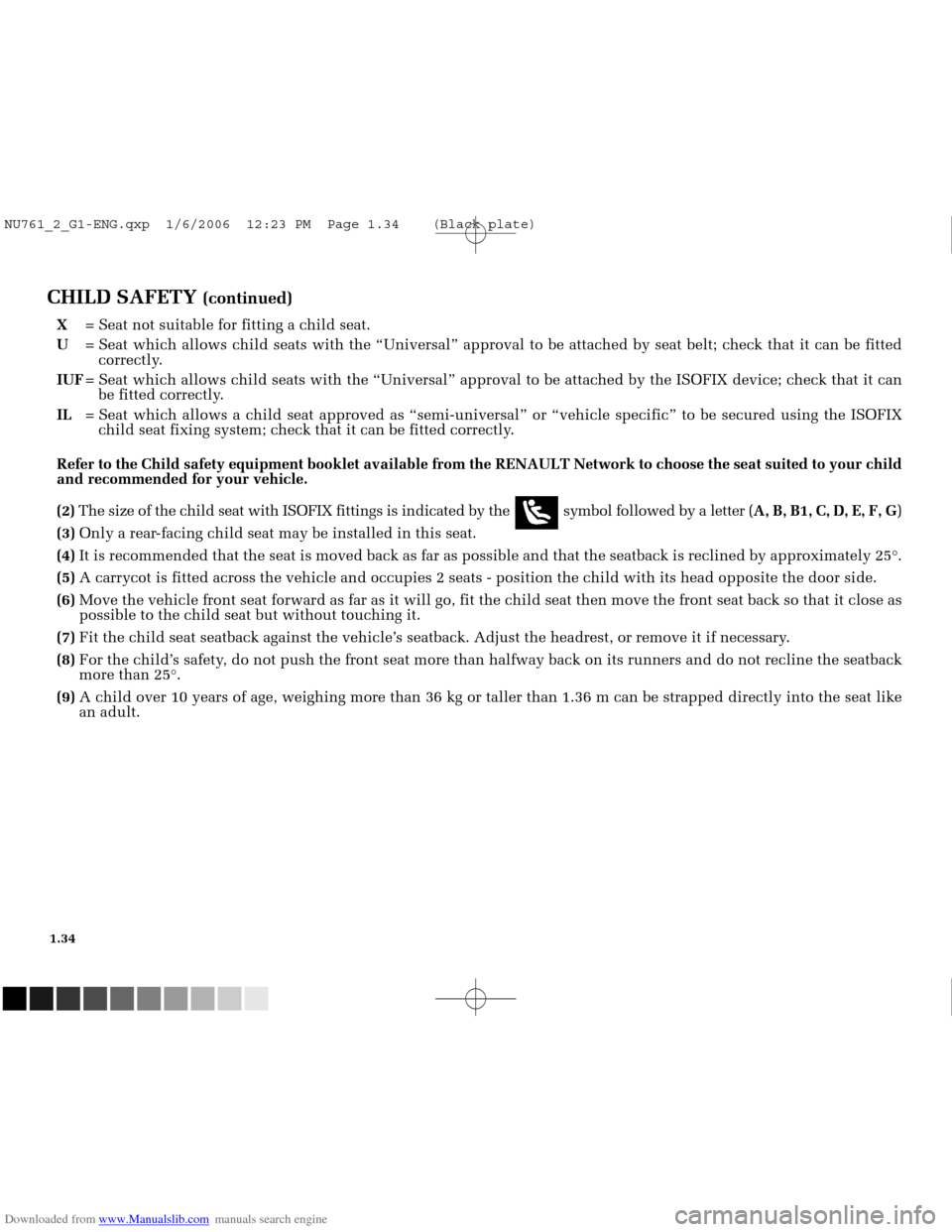
Downloaded from www.Manualslib.com manuals search engine
NU761_2_G1-FRA.qxd 10/11/05 15:53 Page 1.34
1.34
CHILD SAFETY (continued)
X= Seat not suitable for fitting a child seat.
U = Seat which allows child seats with the “Universal” approval to be \
attached by seat belt; check that it can be fitted
correctly.
IUF = Seat which allows child seats with the “Universal” approval to be \
attached by the ISOFIX device; check that it can
be fitted correctly.
IL = Seat which allows a child seat approved as “semi-universal” or “\
vehicle specific” to be secured using the ISOFIX
child seat fixing system; check that it can be fitted correctly.
Refer to the Child safety equipment booklet available from the RENAULT N\
etwork to choose the seat suited to your child
and recommended for your vehicle.
(2) The size of the child seat with ISOFIX fittings is indicated by the symbol followed by a letter ( A, B, B1, C, D, E, F, G)
(3) Only a rear-facing child seat may be installed in this seat.
(4) It is recommended that the seat is moved back as far as possible and tha\
t the seatback is reclined by approximately 25°.
(5) A carrycot is fitted across the vehicle and occupies 2 seats - position \
the child with its head opposite the door side.
(6) Move the vehicle front seat forward as far as it will go, fit the child \
seat then move the front seat back so that it close as
possible to the child seat but without touching it.
(7) Fit the child seat seatback against the vehicle’s seatback. Adjust the headrest, or remove it if necessary.
(8) For the child’s safety, do not push the front seat more than halfway back on its runners and d\
o not recline the seatback
more than 25°.
(9) A child over 10 years of age, weighing more than 36 kg or taller than 1.\
36 m can be strapped directly into the seat like
an adult.
NU761_2_G1-ENG.qxp 1/6/2006 12:23 PM Page 1.34 (Black plate)
Page 45 of 250
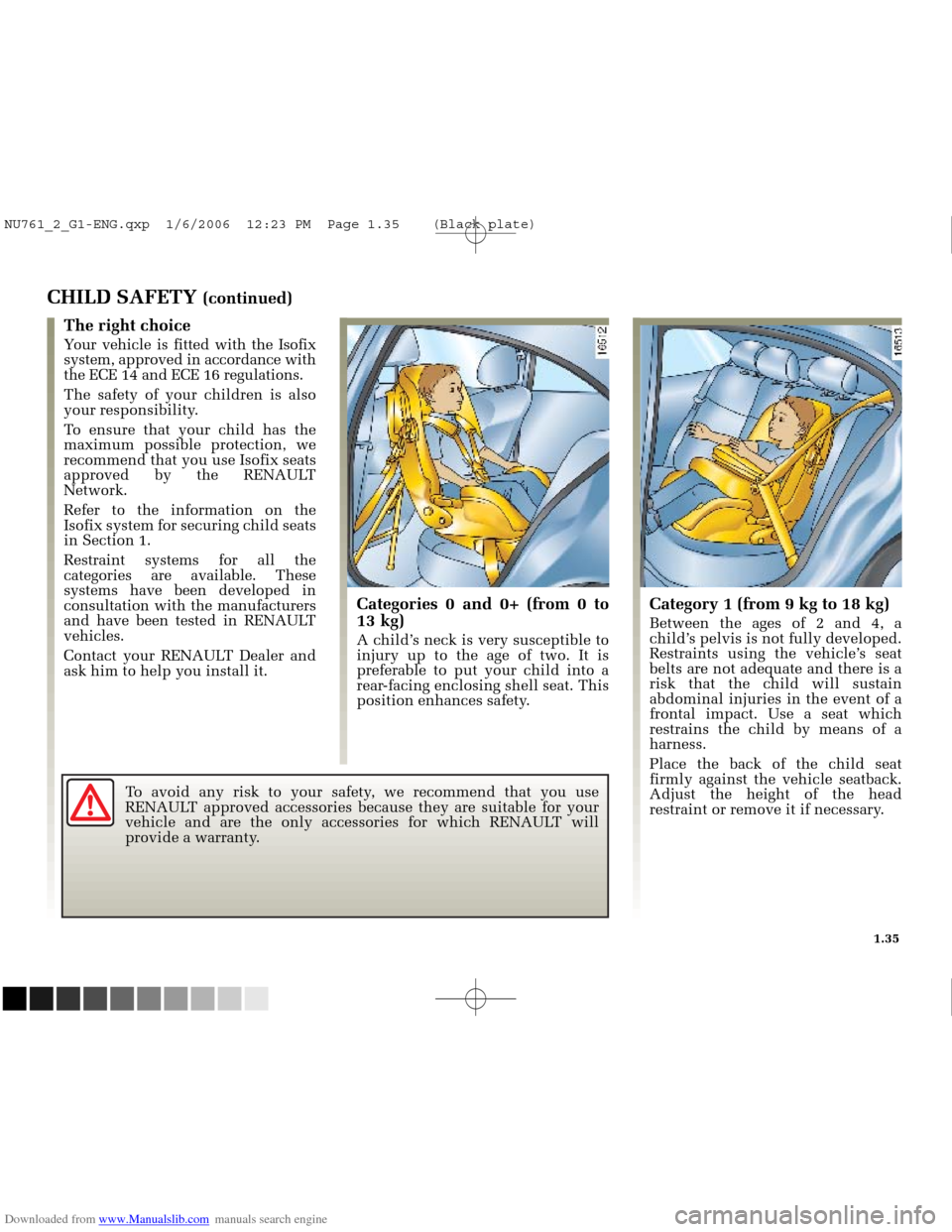
Downloaded from www.Manualslib.com manuals search engine
NU761_2_G1-FRA.qxd 10/11/05 15:53 Page 1.35
1.35
To avoid any risk to your safety, we recommend that you use
RENAULT approved accessories because they are suitable for your
vehicle and are the only accessories for which RENAULT will
provide a warranty.
CHILD SAFETY (continued)
The right choice
Your vehicle is fitted with the Isofix
system, approved in accordance with
the ECE 14 and ECE 16 regulations.
The safety of your children is also
your responsibility.
To ensure that your child has the
maximum possible protection, we
recommend that you use Isofix seats
approved by the RENAULT
Network.
Refer to the information on the
Isofix system for securing child seats
in Section 1.
Restraint systems for all the
categories are available. These
systems have been developed in
consultation with the manufacturers
and have been tested in RENAULT
vehicles.
Contact your RENAULT Dealer and
ask him to help you install it.
Categories 0 and 0+ (from 0 to
13 kg)
A child’s neck is very susceptible to
injury up to the age of two. It is
preferable to put your child into a
rear-facing enclosing shell seat. This
position enhances safety.
Category 1 (from 9 kg to 18 kg)
Between the ages of 2 and 4, a
child’s pelvis is not fully developed.
Restraints using the vehicle’s seat
belts are not adequate and there is a
risk that the child will sustain
abdominal injuries in the event of a
frontal impact. Use a seat which
restrains the child by means of a
harness.
Place the back of the child seat
firmly against the vehicle seatback.
Adjust the height of the head
restraint or remove it if necessary.
NU761_2_G1-ENG.qxp 1/6/2006 12:23 PM Page 1.35 (Black plate)
Page 46 of 250
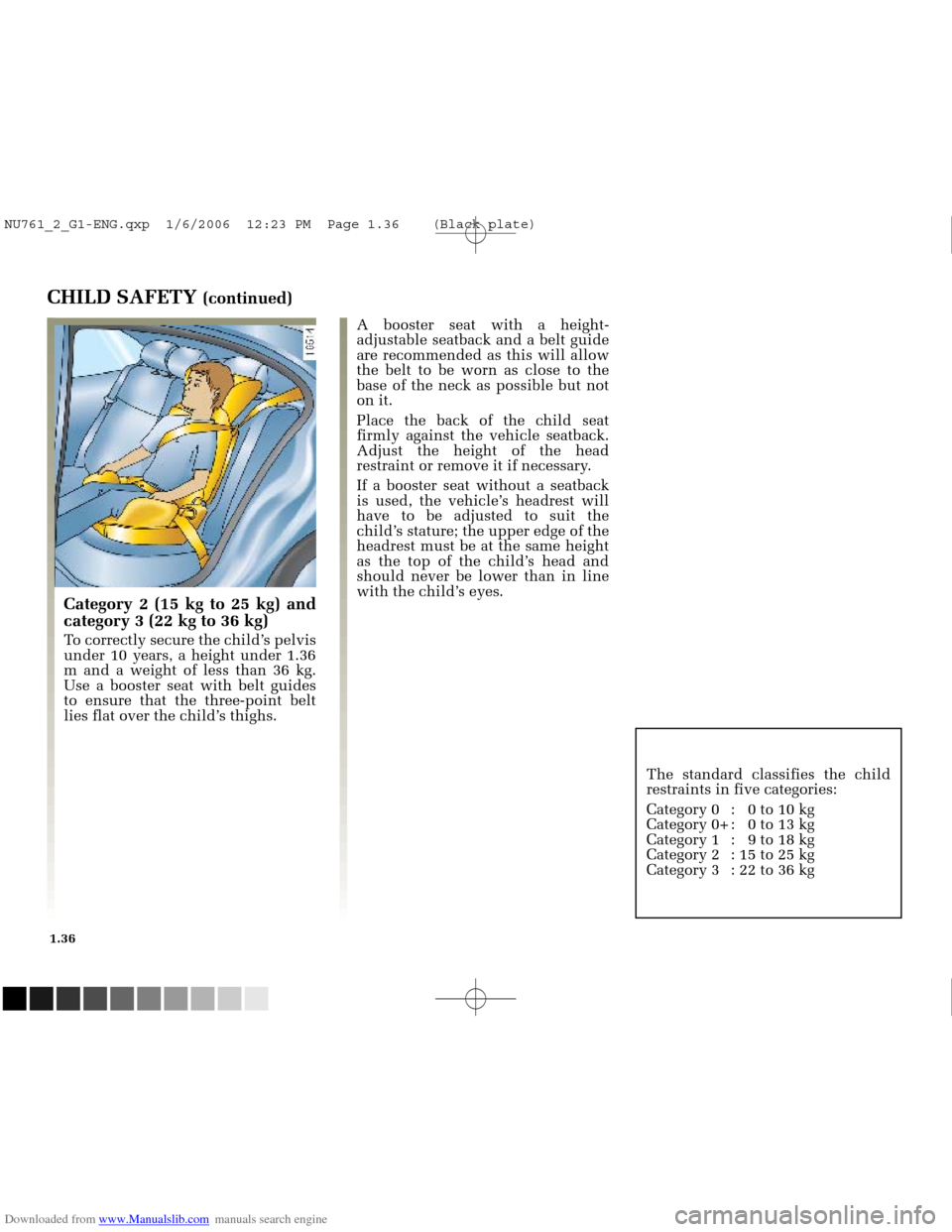
Downloaded from www.Manualslib.com manuals search engine
NU761_2_G1-FRA.qxd 10/11/05 15:53 Page 1.36
1.36
CHILD SAFETY (continued)
A booster seat with a height-
adjustable seatback and a belt guide
are recommended as this will allow
the belt to be worn as close to the
base of the neck as possible but not
on it.
Place the back of the child seat
firmly against the vehicle seatback.
Adjust the height of the head
restraint or remove it if necessary.
If a booster seat without a seatback
is used, the vehicle’s headrest will
have to be adjusted to suit the
child’s stature; the upper edge of the
headrest must be at the same height
as the top of the child’s head and
should never be lower than in line
with the child’s eyes.
Category 2 (15 kg to 25 kg) and
category 3 (22 kg to 36 kg)
To correctly secure the child’s pelvis
under 10 years, a height under 1.36
m and a weight of less than 36 kg.
Use a booster seat with belt guides
to ensure that the three-point belt
lies flat over the child’s thighs.The standard classifies the child
restraints in five categories:
Category 0 : 0 to 10 kg
Category 0+ : 0 to 13 kg
Category 1 : 9 to 18 kg
Category 2 : 15 to 25 kg
Category 3 : 22 to 36 kg
NU761_2_G1-ENG.qxp 1/6/2006 12:23 PM Page 1.36 (Black plate)
Page 47 of 250
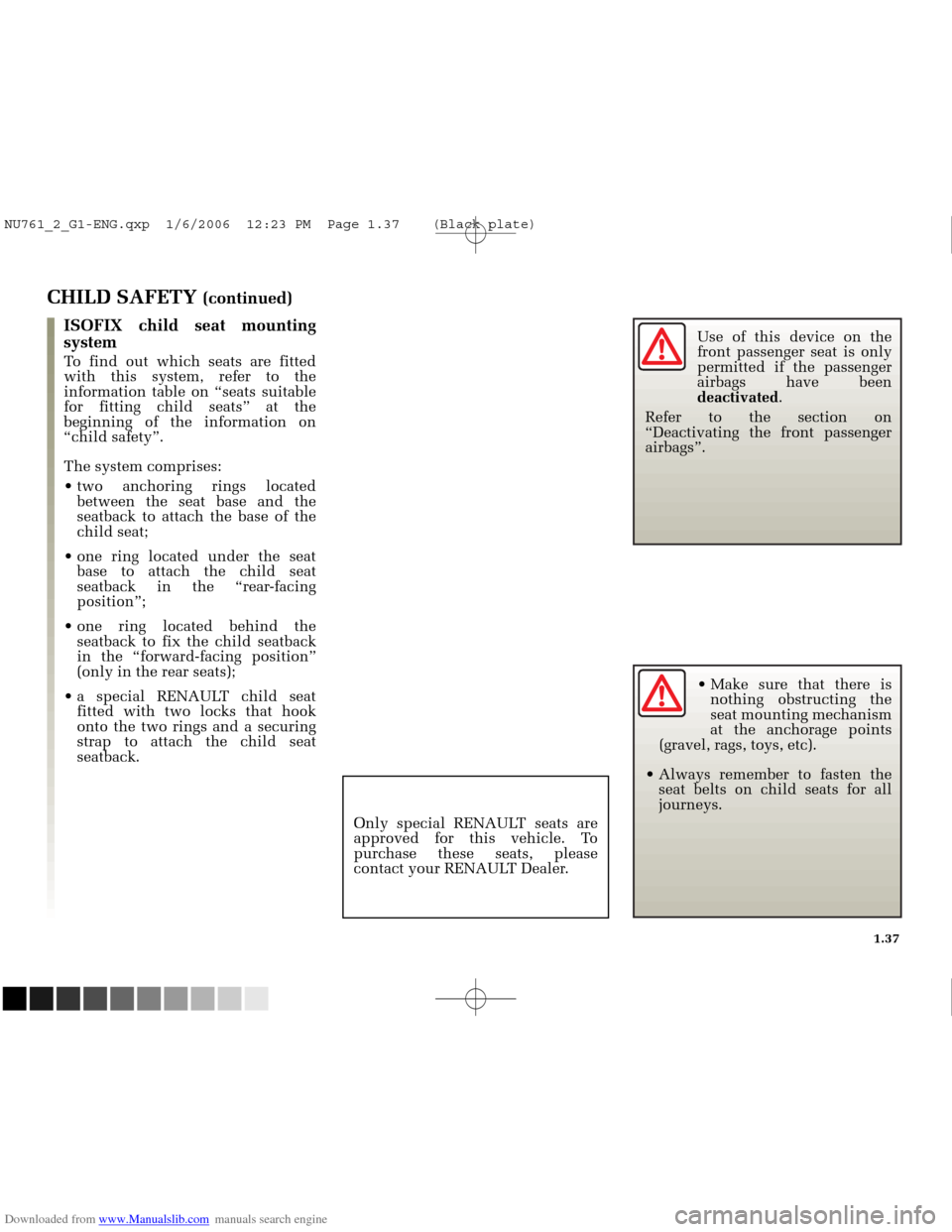
Downloaded from www.Manualslib.com manuals search engine
NU761_2_G1-FRA.qxd 10/11/05 15:53 Page 1.37
1.37
Use of this device on the
front passenger seat is only
permitted if the passenger
airbags have been
deactivated.
Refer to the section on
“Deactivating the front passenger
airbags”.
Make sure that there isnothing obstructing the
seat mounting mechanism
at the anchorage points
(gravel, rags, toys, etc).
Always remember to fasten the seat belts on child seats for all
journeys.
CHILD SAFETY (continued)
ISOFIX child seat mounting
system
To find out which seats are fitted
with this system, refer to the
information table on “seats suitable
for fitting child seats” at the
beginning of the information on
“child safety”.
The system comprises:
two anchoring rings located between the seat base and the
seatback to attach the base of the
child seat;
one ring located under the seat base to attach the child seat
seatback in the “rear-facing
position”;
one ring located behind the seatback to fix the child seatback
in the “forward-facing position”
(only in the rear seats);
a special RENAULT child seat fitted with two locks that hook
onto the two rings and a securing
strap to attach the child seat
seatback.
Only special RENAULT seats are
approved for this vehicle. To
purchase these seats, please
contact your RENAULT Dealer.
NU761_2_G1-ENG.qxp 1/6/2006 12:23 PM Page 1.37 (Black plate)